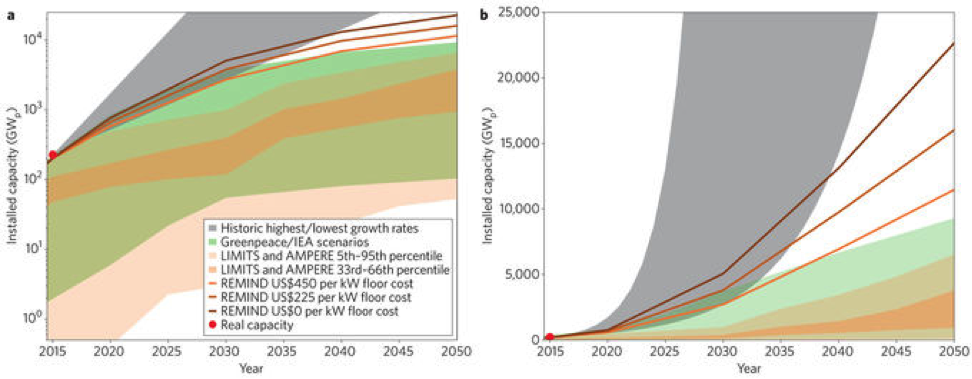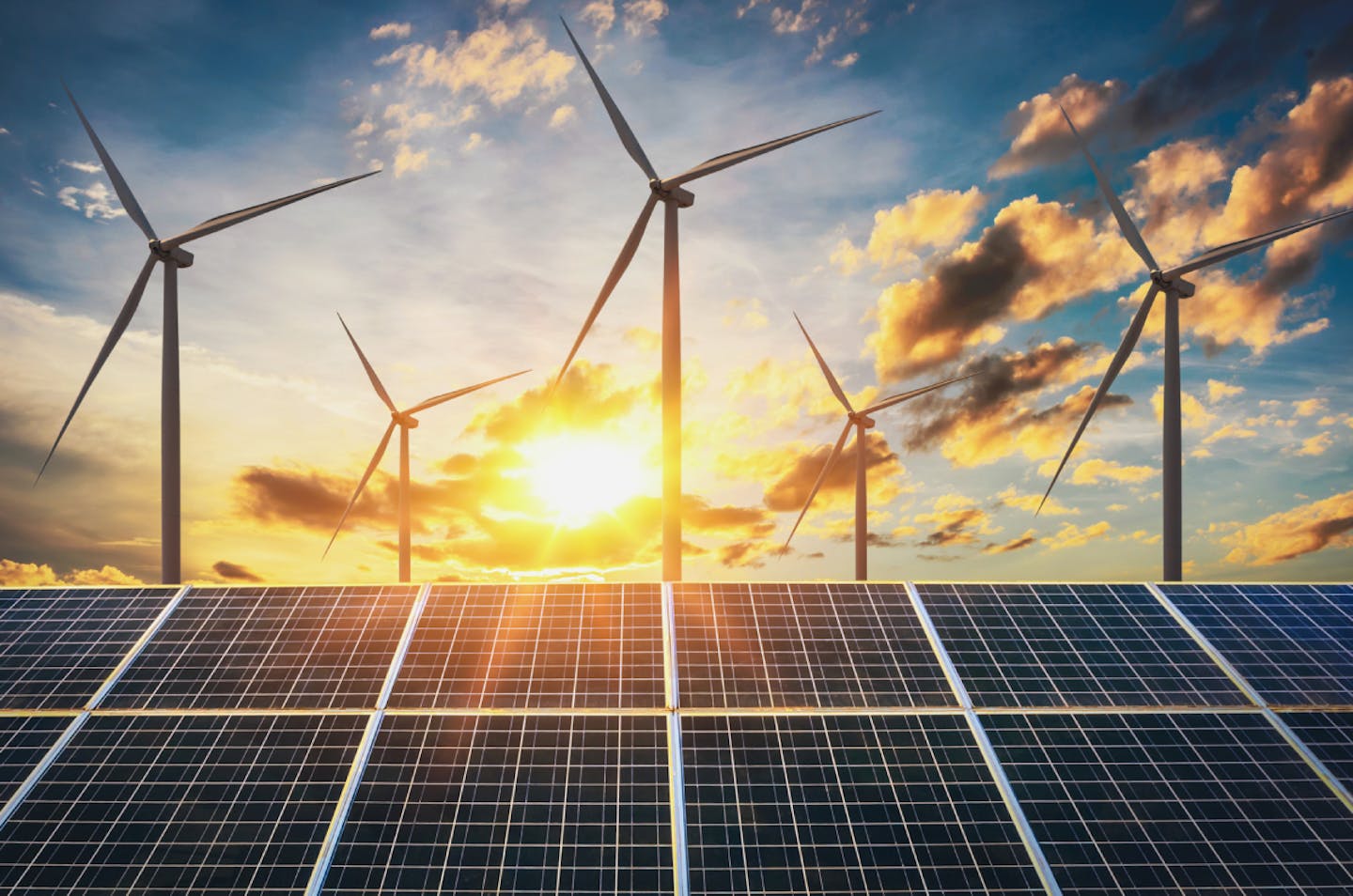100% Renewable Energy
The wind and solar sectors are growing at an exponential rate, far faster than anyone had previously imagined. Prices for renewable power generation are plummeting, in many cases providing a cheaper alternative for utilities than traditional coal or natural gas plants. In 2020 approximately 21% of global energy was met with renewables. Several studies show that a 100% renewable energy system will be significantly cheaper than our current system, unlocking trillions in additional GDP while stimulating the economy through millions of new jobs and billions of dollars in avoided climate and health costs.
There will be opposition. Many governments are continuing to subsidize fossil fuel extraction and production (to the tune of an estimated $5 trillion per year) but the tide is turning. Trillions of dollars in capital are now moving out of fossil fuels and into renewables, and a growing momentum of countries, subnational governments, and cities are now committing to 100% renewable energy. The writing is on the wall, but it will take a massive public movement to overcome the inertia of an entrenched 19th century energy system based on the extraction and combustion of fossil fuels.
One Earth had its roots in a 2014 grant to the Solutions Project, which underwrote a major scientific research project at Stanford University led by Mark Jacobson at the School of Earth, Energy and Environmental Sciences. In 2013 Jacobson made an important discovery while modeling California’s renewable energy potential -- that the State could, in fact, meet more than 99% of its project energy demand by balancing complementary wind, solar, hydro, and geothermal energy resources available regionally. The findings were published in 2014 as “A roadmap for repowering California for all purposes with wind, water, and sunlight.”
One of the most significant findings of the paper was that the net efficiency gained by converting from the combustion of fossil fuels to direct generation greatly reduces projected energy demand by as much as 40% across all uses (power, heating, transportation). This model was repeated for New York and Oregon and then for all 50 U.S. States. In 2015, roadmaps were created for 139 countries (covering over 99% of global CO2 emissions) showing that the entire world could run purely on renewable energy through a regional-based approach to electrification powered by renewable energy resources and enhanced energy efficiency measures.
The global study, published summer 2017, shows that even with rapid development, global energy demand would slightly decrease by 2050 due to end-use efficiency, avoidance of energy-intensive fossil fuel extraction, and net power reduction from improved energy output by electricity over combustion. In the study, projected end-use demand is shown to drop from 12.10 terawatts (TW) in 2012 to 11.96 TW in 2050. Most of this demand can be met through wind and solar. There would be no increase in major hydro projects, though existing dams could be retrofitted for greater efficiency. A small amount of geothermal, wind/tidal, and grid energy storage would be required to maintain a constant baseload of power.

We’re already on the right track. The Renewables 2017 Global Status Report by REN21 shows that indeed renewable energy is dramatically ramping up. 2016 was a landmark year with investments in new renewable power roughly double investments in fossil fuel power ($250B), despite major subsidies to the fossil fuel industry. In the United States in 2017, 94% of all new energy capacity was provided by renewables. One reason for this is plummeting installation costs.
Solar power, which accounted for half of new generation worldwide, is now bidding below 3 cents per kWh in many regions, making it cheaper than fossil fuel generation at market rates. As more carbon pricing regimes come online and fossil fuel extraction becomes more difficult and more expensive, the ROI for fossil fuel and nuclear power generation is too high to justify, even in countries with entrenched fossil fuel interests. Recent policy developments in OPEC nations favoring renewables prove the point.
An analysis of world energy consumption by British Petroleum shows 15.2% annualized growth in new renewables between 2010-2015 in million tonnes of oil equivalent (Mtoe). This will likely accelerate, and by 2020 approximately 12.5% of the world’s total energy demand will be met by renewables (excluding traditional biomass). It should be noted that renewable energy supply is higher than consumption due to regulatory and technological hurdles that should be overcome in the next decade. Given rapid growth in renewables, it is feasible that we could reach a critical milestone, with more than half of the world’s energy supply met by renewable energy.

It should be noted that the global energy analysis is built from specific models for 139 countries (accounting for 99% of global CO2 emissions). This shows the hypothetical avoided emissions if all countries in aggregate were to follow the timeline presented above. While some countries may reach 50% WWS by 2030, many will not. An analysis by University Technology of Sydney is underway to create realistic timelines by economic region synthesized into a more accurate roadmap for global decarbonization. In an initial analysis, it appears that it is possible to avoid approximately more than 1000 GtCO2 emissions relative to the reference case by the year 2050 through renewable energy and energy efficiency.

For those skeptical about the OE renewable energy pathway – which leaps from 25% to 75% in a single decade -- an interesting comparison is the growth curve of mobile technology, which made an even greater leap between 2005-2015 – from 22% to 80% (relative to a market cap of 10B accounts).
Of course we cannot make any direct comparisons between the two industries, but as has been proven across many sectors when a technology reaches maturity it can scale much faster than experts would have originally considered possible. It is our belief that clean renewables could follow a similar rapid adoption curve.
A paper by Creutzig et al. shows that projections for renewable energy growth even by proponents like Greenpeace (shown in green) far underestimated the rapid acceleration of actual installed capacity. Projecting out current levels of growth, the model shows we could approach 100% renewables even in the 2040’s. At this point 100% renewable energy by 2050 seems almost inevitable, and the climate models need to start reflecting this reality.




